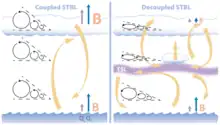
In weather forecasting, decoupling is a process in which two adjacent layers of Earth's atmosphere stop interacting.[2]
Process
During the day when the sun shines and warms the land, air at the surface of the earth is heated and rises. This rising air mixes the atmosphere near the earth. At night, this process stops and air near the surface cools as the land loses heat by radiating in the infrared. If winds are light, air near the surface of the earth can become much colder, compared to the air above it, than if more mixing of air layers occurred.[2][3]
Climate impacts
In mountain valleys at high altitudes, such as those in the Cascade Mountains, decoupling may alter the localized impacts of climate change, as it causes a drastic change in surface and atmospheric temperatures.[4] In coastal regions of the Greenland ice sheet, decoupling may simultaneously help conserve ice sheet mass while limiting new accumulation of ice.[5]
References
- ↑ Nowak, Jakub L.; Siebert, Holger; Szodry, Kai-Erik; Malinowski, Szymon P. (2021-07-20). "Coupled and decoupled stratocumulus-topped boundary layers: turbulence properties". Atmospheric Chemistry and Physics. 21 (14): 10965–10991. doi:10.5194/acp-21-10965-2021. ISSN 1680-7316.
- 1 2 "Glossary of Meteorology: Decoupling". American Meteorological Society. Retrieved 2023-12-01.
- ↑ Derbyshire, S. H. (1999-02-01). "Boundary-Layer Decoupling over Cold Surfaces as a Physical Boundary-Instability". Boundary-Layer Meteorology. 90 (2): 297–325. doi:10.1023/A:1001710014316. ISSN 1573-1472.
- ↑ Daly, Christopher; Conklin, David R.; Unsworth, Michael H. (2010). "Local atmospheric decoupling in complex topography alters climate change impacts". International Journal of Climatology. 30 (12): 1857–1864. doi:10.1002/joc.2007. ISSN 0899-8418.
- ↑ Berkelhammer, Max; Noone, David C.; Steen-Larsen, Hans Christian; Bailey, Adriana; Cox, Christopher J.; O’Neill, Michael S.; Schneider, David; Steffen, Konrad; White, James W. C. (2016). "Surface-atmosphere decoupling limits accumulation at Summit, Greenland". Science Advances. 2 (4). doi:10.1126/sciadv.1501704. ISSN 2375-2548. PMC 4928998. PMID 27386509.